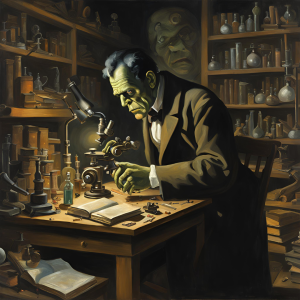If you’re looking for the perfect Frankenstein teaching resources, I have 8 awesome articles for you to teach alongside your unit. From historical information, to an author biography, to excerpts from the most important allusions, these Frankenstein teaching resources have you covered.
The Romantic Movement

The first of the Frankenstein teaching resources I recommend is a one-page overview of the Romantic Movement. It’s really important for your students to understand the cultural background during which Mary Shelley wrote her masterpiece. By reading the first of these Frankenstein teaching resources your students will be better able to spot and appreciate Mary Shelley’s implementation of these techniques.
Mary Shelley Biography: Another of the Frankenstein Teaching Resources

Another resource that will benefit your students is a biography of the author. Mary Shelley expertly crafted so many of her own biographical details into Frankenstein. By reading about this ahead of time, your students will be able to more deeply appreciate all the ways her monster’s life paralleled that of her own.
Gothic Literature
Probably one of my favorite genres is that of Gothic literature. That’s probably also why Frankenstein is one of my favorite novels to read and teach. I think it’s so beautiful how Shelley’s foundational work incorporates elements of the Romantic Movement with those of Gothic literature. Your students will be able to see and understand these elements by reading another one of these Frankenstein teaching resources.
Full-Body Transplants: One of the Unexpected Frankenstein Teaching Resources
Sometimes I feel students write off a given text because it’s “old” and “outdated.” Another reason I love Frankenstein is for the modern relevancy the novel still holds. In the fourth resource, students will read about a recent scientist who experiments with full-body transplants, almost like a modern-day Frankenstein. This article is sure to spark your students’ interest and foster a lively debate over its ethics.
Genetic Engineering
Yet another way Mary Shelley was ahead of her times entails the debate surrounding genetic engineering. Who knew her monster would serve as a precursor for the ways modern humans modify DNA? And not just the DNA of humans but animals and crops, too. It’s yet another of the Frankenstein teaching resources sure to spark a lively discussion among your students.

"Rime of the Ancient Mariner"
One of the pivotal allusions of Mary Shelley’s text is Samuel Taylor Coleridge’s “Rime of the Ancient Mariner.” But of all the Frankenstein teaching resources, it would be very difficult to squeeze this one in. So I offer my students an abridged summary of the expansive text. I find it helps students understand and appreciate the allusion without slowing down the pacing of my unit.
The Myth of Prometheus

One of the most fiery Frankenstein teaching resources (see what I did there?) is teaching students all about the myth of Prometheus. It’s another resource that could take a really long time, but I’ve tailored the myth to include the most important details only. After reading about the myth, I have my students compare the myth to that of Shelley’s Frankenstein. For me, this usually occurs about a third of the way through the novel.
"Prometheus Unbound"
Another one of the very long resources would be Percy Bysshe Shelley’s “Prometheus Unbound.” Though it’s rife with allusionary value, it’s simply too long to include in my half-year course. So I carefully selected the most relevant excerpt and have my students compare it with his wife’s more enjoyable text.
A Summary of My Favorite Frankenstein Teaching Resources
Every year, I look forward to teaching Mary Shelley’s text not only for the value of the story itself but for the Frankenstein teaching resources I’ve accumulated over the years. If you found any of those listed here to be interesting, check out even more I have to offer.
- Frankenstein Complementary Articles with Spanish Translation: All 8 Frankenstein teaching resources covered in this post are included here PLUS THEIR SPANISH TRANSLATIONS
- Frankenstein ELL ELD ESL Spanish Translation Booklet: It’s the perfect accompaniment for Spanish speakers in your classroom
- Paradise Lost and Frankenstein: Close Reading and Pairing Activity: It’s another one of those allusions so critical to understanding the text
- Tracking Frankenstein: An engaging, digital activity to help your students see just how far Frankenstein traveled
- Frankenstein and the Myth of Prometheus: Here’s another version of the allusion, which comes with the text and a comparative activity





